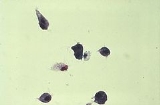
Trichomonas vaginalis
Overview
Trichomonas vaginalis is an anaerobic
, flagellate
d protozoan, a form of microorganism
. The parasitic microorganism is the causative agent of trichomoniasis
, and is the most common pathogen
ic protozoan infection of humans in industrialized countries. Infection rates between men and women are the same with women showing symptoms while infections in men are usually asymptomatic. Transmission takes place directly because the trophozoite does not have a cyst
.
Anaerobic organism
An anaerobic organism or anaerobe is any organism that does not require oxygen for growth. It could possibly react negatively and may even die if oxygen is present...
, flagellate
Flagellate
Flagellates are organisms with one or more whip-like organelles called flagella. Some cells in animals may be flagellate, for instance the spermatozoa of most phyla. Flowering plants do not produce flagellate cells, but ferns, mosses, green algae, some gymnosperms and other closely related plants...
d protozoan, a form of microorganism
Microorganism
A microorganism or microbe is a microscopic organism that comprises either a single cell , cell clusters, or no cell at all...
. The parasitic microorganism is the causative agent of trichomoniasis
Trichomoniasis
Trichomoniasis, sometimes referred to as "trich", is a common cause of vaginitis. It is a sexually transmitted disease, and is caused by the single-celled protozoan parasite Trichomonas vaginalis producing mechanical stress on host cells and then ingesting cell fragments after cell death...
, and is the most common pathogen
Pathogen
A pathogen gignomai "I give birth to") or infectious agent — colloquially, a germ — is a microbe or microorganism such as a virus, bacterium, prion, or fungus that causes disease in its animal or plant host...
ic protozoan infection of humans in industrialized countries. Infection rates between men and women are the same with women showing symptoms while infections in men are usually asymptomatic. Transmission takes place directly because the trophozoite does not have a cyst
Cyst
A cyst is a closed sac, having a distinct membrane and division on the nearby tissue. It may contain air, fluids, or semi-solid material. A collection of pus is called an abscess, not a cyst. Once formed, a cyst could go away on its own or may have to be removed through surgery.- Locations :* Acne...
.

